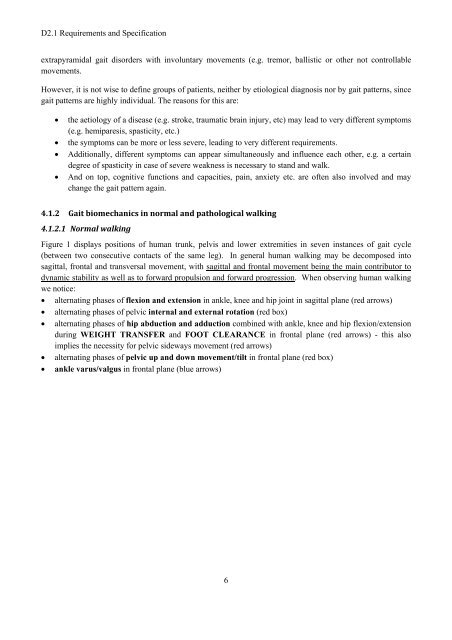D2.1 Requirements and Specification - CORBYS
D2.1 Requirements and Specification - CORBYS
D2.1 Requirements and Specification - CORBYS
You also want an ePaper? Increase the reach of your titles
YUMPU automatically turns print PDFs into web optimized ePapers that Google loves.
<strong>D2.1</strong> <strong>Requirements</strong> <strong>and</strong> <strong>Specification</strong><br />
extrapyramidal gait disorders with involuntary movements (e.g. tremor, ballistic or other not controllable<br />
movements.<br />
However, it is not wise to define groups of patients, neither by etiological diagnosis nor by gait patterns, since<br />
gait patterns are highly individual. The reasons for this are:<br />
� the aetiology of a disease (e.g. stroke, traumatic brain injury, etc) may lead to very different symptoms<br />
(e.g. hemiparesis, spasticity, etc.)<br />
� the symptoms can be more or less severe, leading to very different requirements.<br />
� Additionally, different symptoms can appear simultaneously <strong>and</strong> influence each other, e.g. a certain<br />
degree of spasticity in case of severe weakness is necessary to st<strong>and</strong> <strong>and</strong> walk.<br />
� And on top, cognitive functions <strong>and</strong> capacities, pain, anxiety etc. are often also involved <strong>and</strong> may<br />
change the gait pattern again.<br />
4.1.2 Gait biomechanics in normal <strong>and</strong> pathological walking<br />
4.1.2.1 Normal walking<br />
Figure 1 displays positions of human trunk, pelvis <strong>and</strong> lower extremities in seven instances of gait cycle<br />
(between two consecutive contacts of the same leg). In general human walking may be decomposed into<br />
sagittal, frontal <strong>and</strong> transversal movement, with sagittal <strong>and</strong> frontal movement being the main contributor to<br />
dynamic stability as well as to forward propulsion <strong>and</strong> forward progression. When observing human walking<br />
we notice:<br />
� alternating phases of flexion <strong>and</strong> extension in ankle, knee <strong>and</strong> hip joint in sagittal plane (red arrows)<br />
� alternating phases of pelvic internal <strong>and</strong> external rotation (red box)<br />
� alternating phases of hip abduction <strong>and</strong> adduction combined with ankle, knee <strong>and</strong> hip flexion/extension<br />
during WEIGHT TRANSFER <strong>and</strong> FOOT CLEARANCE in frontal plane (red arrows) - this also<br />
implies the necessity for pelvic sideways movement (red arrows)<br />
� alternating phases of pelvic up <strong>and</strong> down movement/tilt in frontal plane (red box)<br />
� ankle varus/valgus in frontal plane (blue arrows)<br />
6


